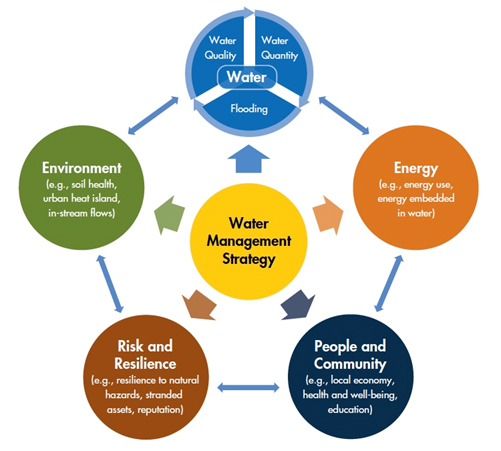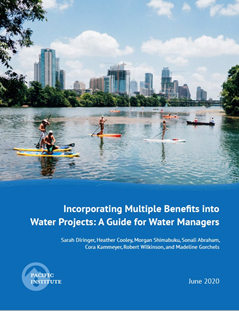Taking Stock Of The Value In Distributed Water Infrastructure


In the spirit of ‘never let a good crisis go to waste,’ a recent addition to the Pacific Institute website calls attention to the merits of distributed water infrastructure as one response to financial challenges caused by the COVID-19 crisis and other such financially stressful events. Here are some of its latest recommendations for using distributed water infrastructure to help meet those challenges.
Time For New Perspectives
The motivations for rethinking distributed water infrastructure extend beyond the financial implications of the COVID-19 crisis alone. In addition to reductions in water demand and disruptions in cash flow caused by non-payment of water and sewer bills stemming from the coronavirus pandemic, the impacts of climate change continue to strain water-related infrastructure. This Pacific Institute webpage introducing the concept of distributed infrastructure highlights two in-depth reports that advocate rethinking strategic approaches to drinking water, wastewater, and stormwater infrastructure. Both documents include references to benefits achieved in actual projects undertaken by various municipalities.
- Innovation in Action: 21st Century Water Infrastructure Solutions. San Francisco, Calif.: WaterNow Alliance. This paper authored by Cynthia Koehler, the executive director of WaterNow Alliance, and Caroline Koch, the water policy director at WaterNow Alliance, provides expanded insights into decentralized, distributed infrastructure solutions that are already paying dividends.
An important financial focus addressed in the document is that “utilities can deploy municipal bond proceeds to finance localized water infrastructure,” based on a 2018 ruling by the Governmental Accounting Standards Board (GASB). That includes capitalizing and debt-financing distributed infrastructure and water-conservation incentives instead of having to pay for them strictly out of operating cash. This series of three blogs on Financing the Future of Water Infrastructure further explains that important concept. Also, this Tap Into Resilience Toolkit provides scores of resources to help make such infrastructure financing a reality.
The document highlights a wide range of distributed infrastructure applications where readers can benefit — including source-watershed protection, water-use efficiency, private service-line replacement, non-potable water alternatives (including reuse), plus stormwater and flood management. Water professionals can learn from the first-hand experience of their colleagues across 13 case-study profiles cited in the document, including specific projects in:
- Long-Term Water-Resource Planning. The Austin, TX, Water Forward plan is the result of an 8-year drought that forced city leaders to confront the challenges of a growing city in a changing climate. It anticipates 10 MGD of community-scale onsite reuse to satisfy one-third of all new water demands to be added by 2040. This will help one of the fastest-growing U.S. cities prepare to serve 2-million customers on 33” of average annual rainfall that accumulates in feast-or-famine bursts.
- Lead-Service-Line Replacement. The water utility serving the City of Madison, WI, replaced lead service lines on private water connections to remove the source of the problem instead of trying to mitigate it through their central water treatment infrastructure. That helped them save millions of dollars in chemical treatment costs and reduce wastewater phosphorus discharges resulting from orthophosphate treatments, all while achieving compliance with the U.S. EPA’s Lead and Copper Rule.
- Stormwater Capture. The Metropolitan Milwaukee Sanitary District is using green infrastructure to complement existing underground storage tunnels to capture and store up to 740 MG of stormwater while eliminating combined sewer overflows (CSOs).
Cover image courtesy of Pacific Institute. Diringer, Sarah, Heather Cooley, Morgan Shimabuku, Sonali Abraham, Madeline Gorchels, Cora Kammeyer, and Robert Wilkinson. 2020. Incorporating Multiple Benefits into Water Projects: A Guide for Water Managers. Oakland, Calif.: Pacific Institute.
Figure 1. This Pacific Institute Guide for Water Managers provides an in-depth look at strategic approaches, financial considerations, and case-study examples for better distributed-infrastructure investments.
- Incorporating Multiple Benefits into Water Projects: A Guide for Water Managers. Oakland, Calif.: Pacific Institute. This planning overview document (Figure 1) offers a framework for decision-making on water infrastructure investments. It stresses the value and benefits of a holistic, integrated strategy and not just a cost-of-infrastructure approach to help project planners expand their scope of engagement with potential supporters and beneficiaries of distributed infrastructure (Figure 2). In an industry where hardware and infrastructure technologies receive the bulk of high-profile coverage, this document provides an important counterpoint on using the co-benefits of infrastructure investment as a way to “build partnerships, leverage additional resources, and garner public support.” The key steps to its framework include:
- Envisioning the project by thinking broadly about challenges and potential solutions with regard to stakeholders.
- Identifying benefits and tradeoffs, with an eye toward expanding the scope of benefits and connecting them with key beneficiaries.
- Characterizing key benefits and tradeoffs, using honest risk assessment and specific metrics to evaluate success.
- Informed decision-making that benefits from communicating the results of the up-front project analysis to internal decision-makers and the public.

Graphic courtesy of Pacific Institute. Diringer, Sarah, Heather Cooley, Morgan Shimabuku, Sonali Abraham, Madeline Gorchels, Cora Kammeyer, and Robert Wilkinson. 2020. Incorporating Multiple Benefits into Water Projects: A Guide for Water Managers. Oakland, Calif.: Pacific Institute
Figure 2. The Pacific Institute Guide for Water Managers emphasizes the importance of balancing multiple aspects of water management strategies in order to maximize the value of investments in traditional and distributed infrastructure.
The document walks project planners through those four key steps with a series of 15 DO or DON’T guidelines and explanations, such as:
- DO engage with stakeholders to understand the problem and define the solutions.
- DO examine equity throughout the process.
- DON’T forget about tradeoffs, or ignore uncertainty.
- DO determine appropriate metrics for evaluating benefits and tradeoffs.
- DON’T let the perfect be the enemy of the good.
Finally, as a way of making its conceptual approaches more tangible, the document also includes numerous links to information, tools, and case studies that illustrate and support the principles outlined there.

